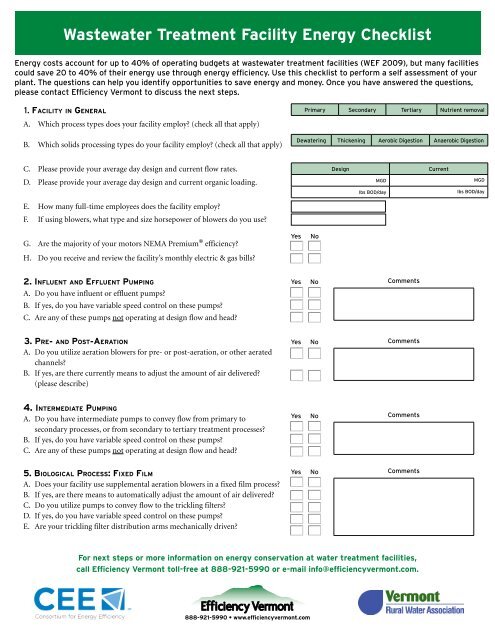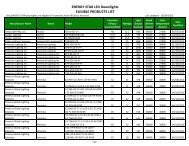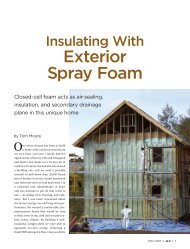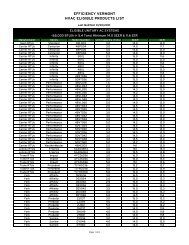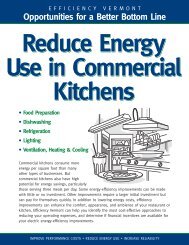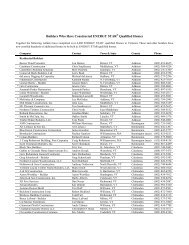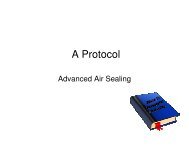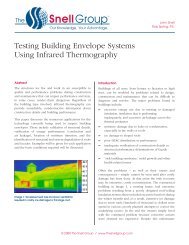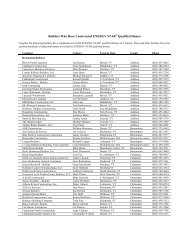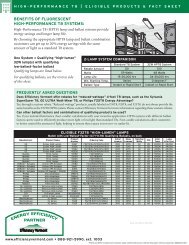Wastewater Facility Energy Checklist for Self-Assessment
Wastewater Facility Energy Checklist for Self-Assessment
Wastewater Facility Energy Checklist for Self-Assessment
You also want an ePaper? Increase the reach of your titles
YUMPU automatically turns print PDFs into web optimized ePapers that Google loves.
<strong>Wastewater</strong> Treatment <strong>Facility</strong> <strong>Energy</strong> <strong>Checklist</strong><br />
<strong>Energy</strong> costs account <strong>for</strong> up to 40% of operating budgets at wastewater treatment facilities (WEF 2009), but many facilities<br />
could save 20 to 40% of their energy use through energy efficiency. Use this checklist to per<strong>for</strong>m a self assessment of your<br />
plant. The questions can help you identify opportunities to save energy and money. Once you have answered the questions,<br />
please contact Efficiency Vermont to discuss the next steps.<br />
1. <strong>Facility</strong> in General<br />
A. Which process types does your facility employ (check all that apply)<br />
B. Which solids processing types do your facility employ (check all that apply)<br />
C. Please provide your average day design and current flow rates.<br />
D. Please provide your average day design and current organic loading.<br />
Primary Secondary Tertiary Nutrient removal<br />
<br />
Dewatering Thickening Aerobic Digestion Anaerobic Digestion<br />
<br />
Design<br />
Current<br />
MGD<br />
MGD<br />
lbs BOD/day<br />
lbs BOD/day<br />
E. How many full-time employees does the facility employ<br />
F. If using blowers, what type and size horsepower of blowers do you use<br />
G. Are the majority of your motors NEMA Premium® efficiency<br />
H. Do you receive and review the facility’s monthly electric & gas bills<br />
Yes<br />
<br />
<br />
No<br />
<br />
<br />
2. Influent and Effluent Pumping<br />
A. Do you have influent or effluent pumps<br />
B. If yes, do you have variable speed control on these pumps<br />
C. Are any of these pumps not operating at design flow and head<br />
Yes<br />
<br />
<br />
<br />
No<br />
<br />
<br />
<br />
Comments<br />
3. Pre- and Post-Aeration<br />
A. Do you utilize aeration blowers <strong>for</strong> pre- or post-aeration, or other aerated<br />
channels<br />
B. If yes, are there currently means to adjust the amount of air delivered<br />
(please describe)<br />
Yes<br />
<br />
<br />
No<br />
<br />
<br />
Comments<br />
4. Intermediate Pumping<br />
A. Do you have intermediate pumps to convey flow from primary to<br />
secondary processes, or from secondary to tertiary treatment processes<br />
B. If yes, do you have variable speed control on these pumps<br />
C. Are any of these pumps not operating at design flow and head<br />
Yes<br />
<br />
<br />
<br />
No<br />
<br />
<br />
<br />
Comments<br />
5. Biological Process: Fixed Film<br />
A. Does your facility use supplemental aeration blowers in a fixed film process<br />
B. If yes, are there means to automatically adjust the amount of air delivered<br />
C. Do you utilize pumps to convey flow to the trickling filters<br />
D. If yes, do you have variable speed control on these pumps<br />
E. Are your trickling filter distribution arms mechanically driven<br />
Yes<br />
<br />
<br />
<br />
<br />
<br />
No<br />
<br />
<br />
<br />
<br />
<br />
Comments<br />
For next steps or more in<strong>for</strong>mation on energy conservation at water treatment facilities,<br />
call Efficiency Vermont toll-free at 888-921-5990 or e-mail info@efficiencyvermont.com.<br />
888-921-5990 • www.efficiencyvermont.com
6. Biological Process: Activated Sludge and Aerated Lagoons<br />
A. Does your facility use mechanical aerators<br />
B. If yes, do the aerators have variable speed control<br />
C. Are the aerators controlled by a timer<br />
D. Do you utilize aeration blowers as part of the activated sludge process<br />
E. Is the DO level in any of your aeration basins >2.0 If yes, please explain.<br />
F. Is your aeration system automatically controlled via DO levels and/or<br />
pressure differentials<br />
G. If yes, are DO sensors located within each aeration basin<br />
H. Do you currently use a fine-bubble aeration system<br />
I. Do you have means of detecting diffuser fouling (please describe)<br />
J. Do you currently have variable speed RAS pumps<br />
K. Do you currently have variable speed WAS pumps<br />
7. Disinfection<br />
A. Do you currently use an ultraviolet disinfection system<br />
B. If yes, does the UV system utilize low-pressure, high-output lamps<br />
C. Is the system currently operated via flow-pacing and/or dosing setpoint<br />
based on water quality<br />
Yes<br />
<br />
<br />
<br />
<br />
<br />
<br />
<br />
<br />
<br />
<br />
Yes<br />
<br />
<br />
<br />
No<br />
<br />
<br />
<br />
<br />
<br />
<br />
<br />
<br />
<br />
<br />
<br />
No<br />
<br />
<br />
<br />
Comments<br />
Comments<br />
8. Sludge Pumping<br />
A. Does your facility process sludge less than 24 hours/day<br />
B. Does your sludge handling process have equalization capacity<br />
C. If no, do you have variable speed capability on your sludge transfer pumps<br />
D. Are any of these pumps not operating at design flow and head<br />
Yes<br />
<br />
<br />
<br />
<br />
No<br />
<br />
<br />
<br />
<br />
Comments<br />
9. Sludge Stabilization<br />
A. Does your facility utilize aerobic digestion<br />
B. If yes, has there been consideration of anaerobic digestion<br />
C. Do you have capability to produce biogas from anaerobic digestion processes<br />
D. If yes, do you practice beneficial reuse of the biogas<br />
Yes<br />
<br />
<br />
<br />
<br />
No<br />
<br />
<br />
<br />
<br />
Comments<br />
10. Sludge Thickening & Dewatering<br />
A. Does your thickening/dewatering equipment run less than 24 hours/day<br />
B. Do you use centrifuges <strong>for</strong> thickening, dewatering, or both<br />
C. Do you use sludge drying beds <strong>for</strong> dewatering<br />
D. Do you haul sludge to another location <strong>for</strong> processing<br />
E. Do you use incineration <strong>for</strong> sludge stabilization/disposal<br />
Yes<br />
<br />
<br />
<br />
<br />
<br />
No<br />
<br />
<br />
<br />
<br />
<br />
Comments<br />
11. Other<br />
A. Has your facility undergone energy efficiency projects in the past five years<br />
B. Is or will your facility be undergoing renovation to comply with permitting<br />
requirements or to meet capacity needs<br />
C. If yes, are energy conservation measures included as part of this renovation<br />
D. Do you have a backup generator capable of powering your facility<br />
Do you have ideas or plans that could improve the operating efficiency of your facility<br />
If so, please provide below:<br />
Contact In<strong>for</strong>mation<br />
Your Name:<br />
<strong>Facility</strong> Address:<br />
E-mail Address:<br />
Yes<br />
<br />
<br />
<br />
<br />
<strong>Facility</strong> Name:<br />
Phone Number:<br />
No<br />
<br />
<br />
<br />
<br />
Comments<br />
NOTE: This checklist is an in<strong>for</strong>mational tool. Submitting<br />
the completed checklist to Efficiency Vermont entails no<br />
commitment on the part of yourself or your facility to make<br />
process or operations changes. Consult with a professional<br />
engineer prior to making process changes that may impact<br />
drinking water quality or public health. This checklist was<br />
developed by Consortium <strong>for</strong> <strong>Energy</strong> Efficiency (CEE) with<br />
help from engineering professionals.<br />
RGEN68a-0211


